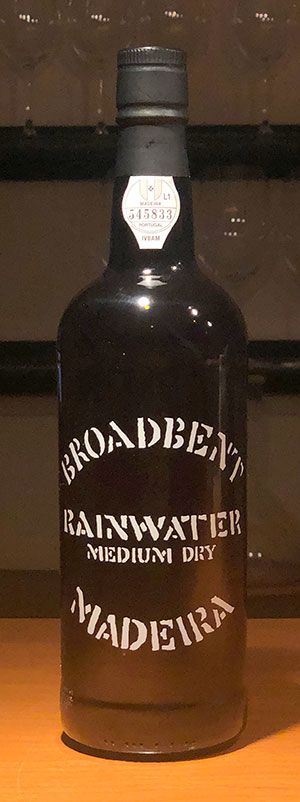
Broadbent Rainwater
Ports, Sherries, Marsalas, and Madeiras are all beverages that fall under the broad category of fortified wines. During fermentation, the wine is “fortified” with brandy or neutral grain spirits. Originally, this was done to preserve and stabilize the wine for shipment, usually to England. It is now done to create sweet wine; the addition of the alcohol kills the fermentation yeasts, retaining any residual sugar.
A true Madeira such as this one comes from Portugal’s Madeira island, about 400 miles due west of Morocco in northern Africa. The small island has an oceanic, tropically-influenced climate and volcanic soil. Because of high heat and humidity, fungal diseases and botrytis (also known as grey mold) are constant hazards. To combat them, Madeira vineyards are often planted in low trellises known as latada that raise the canopy off the ground. The wine is cultivated in terraced steps of red and basaltic bedrock called poios.
Madeira’s unique flavor comes from two elements that would ruin other wines: heat and oxidation. During the era when the earliest Madeiras were shipped, it was discovered that aeration of the sloshing barrels in the warm hold of the ship made for delightful wine. (The Kelt line of cognacs get the same treatment even today.) As for Madeira, the process is emulated through the estufagem process, whereby the wine is placed in hot rooms or heated tanks (estufas) and slowly baked for a minimum of 90 days. Depending on when they are dosed with alcohol, Madeiras can range from quite dry to very sweet.
There are four distinct styles of Madeira. The pale, golden Sercial is the driest and lightest. Verdelho is sweeter and stronger, and Boal is fuller and sweeter still. Malmsey is the richest, darkest, and sweetest of all.
Although the history of Madeira goes as far back as the 18th century, Broadbent has been producing wines in Portugal for just over 20 years. In the mid-1990s Michael Broadbent, Director of Christie’s auction house, prolific wine author, and Madeira expert, partnered with Justino’s Madeira Wines, S.A. to create the Broadbent line. Justino’s was formed as a limited company in 1953, although it had been in existence since 1870 in Madeira as a private family company, when it was known as “Justino Henriques.”
BARTHOLOMEW BROADBENT
Broadbent is now helmed by Michael’s son Bartholomew. He was raised in the English wine trade in a formal apprenticeship to his father. The Broadbent line includes Port from the Douro, Madeiras and Vinho Verde from Portugal, and a Gruner Veltliner made in Austria.
He is credited as being responsible for the growth of Port consumption in North America during the mid 1980s. He was responsible for the re-introduction of Madeira to America in 1989, and instrumental in its growth since then.
He currently lives in Virginia, where he is also involved in the distribution of Virginia wines, now available in over 30 states.
Broadbent Rainwater Madeira
“Rainwater” is a soft, medium dry variant of Verdelho. According to legend, early shipments of Madeira were left on the island’s beaches to await pickup prior to shipment. During that time, the barrels absorbed water during rain showers. This diluted the alcohol and created a less potent wine.
This is one of six Madeiras under the Broadbent label. (There are 11 others branded as Justino’s produced by the house.) The fruit is 98% Tinta Negra, and 2% other regional red varieties. Aged in oak casks for at least three years, this wine is dark orange in color, with a nose of dried dates, figs, and orange peel. There are fresh citrus and caramel flavors on the full-bodied, satiny palate backed up with a zoomy acidity. It is indeed medium dry. It can be served as an apéritif or as an after-dinner drink. The ABV is 19% and 20,000 cases were produced.
Back to blog posts: winervana.com/blog/
